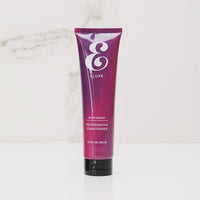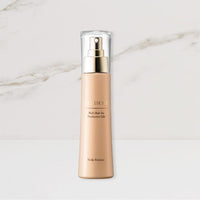How To Keep Dyed Hair Healthy: The Ultimate Guide
There is something freeing and exciting about expressing yourself by changing up your hair color. A new hair color can change your appearance and really boost your self-confidence.
However, before you schedule with the salon, it’s important to know how to take care of bleached and dyed hair. If you’re not careful to take steps to keep your dyed hair healthy, you can end up with split ends, breakage, and rough hair shafts.
How Dyeing and Bleaching Affects Your Hair
Bleaching and dyeing both do similar things: They transform the color of your hair. Though the desired result is similar, the processes used for bleaching and dyeing are a little different.
Bleaching
Bleach doesn’t put a light color into your hair—it strips your hair of its natural pigment, causing it to look lighter. Bleaching is a multi-step process.
First, an alkaline agent is applied to the hair to make the cuticle of your hair open up. Next, an oxidative agent penetrates the hair and dissolves the pigment. The longer you leave the oxidative agent on your hair, the lighter it will become.
Forcing the cuticle of your hair open with the alkaline agent can damage your hair. The cuticle will remain open after bleaching, causing your hair to feel rough and be more susceptible to breakage.
How to Take Care of Bleached Hair
Sorry, ladies—there’s no way to completely prevent damage to your hair when bleaching. Bleaching is all about chemically altering your hair to change its appearance, so it’s important to understand that the lovely platinum blonde color you’re longing for will come at a price.
However, there are things you can do to minimize hair damage caused by bleaching:
- Don’t be cheap. You get what you pay for with bleach. So pay for good quality bleaching supplies (if you’re doing it yourself) or better yet, hire a professional at a salon.
- Don’t leave the bleach on too long. Do not leave bleach on your hair for more than 45 minutes (less if you have lighter colored hair). You can cause breakage and even see some hair fall out.
- Consider pre-conditioning your hair with coconut oil before you bleach. Some studies have shown that coconut oil can help protect your hair during the bleaching process and prevent damage.
Dyeing
Dyeing is all about putting pigment into your hair. However, to do so, most permanent dyes actually start by bleaching your hair. The cuticle is opened up with an alkaline agent (usually ammonia) and bleached with peroxide.
It is only after your hair’s cuticle has been opened and the pigment is lifted that dye is introduced. The dye molecules soak into the hair, transforming the color. Often, a special conditioner is applied to the hair afterward to close up the cuticle.
Temporary dyes do not open the hair cuticle; rather, the dye is just applied to the outside of the hair strands. That is why the dye does not last as long and washes off easily.
How to Take Care of Dyed Hair
Just like bleaching, hair dye isn’t natural for your hair, so it’s understandable that there will be some damage done. But the damage does not need to be excessive, and it’s still possible to keep dyed hair relatively healthy.
Follow these tips to keep hair damage at a minimum during the dyeing process:
- Get greasy. Avoid washing your hair for a few days before applying dye to allow your scalp to build up a natural oil barrier to protect your skin from irritation.
- Do your roots last. Do not apply product on your roots first (if you are dyeing your hair yourself). Start in the middle, work your way down to the ends, then do the roots last.
- Get professional help. If your hair is damaged, dyeing your hair by yourself can be extremely risky and can end up causing even more damage. Go to a salon instead and get a stylist to do it professionally.
Keeping Hair Healthy After Dyeing or Bleaching
After your hair has been bleached or dyed, you may notice that it is more dry or brittle than before. Your hair texture may also change, making it feel rougher. But don’t despair! With a bit of TLC, treated hair can still be beautiful, shiny, and soft.
How to Wash Your Hair After It Has Been Bleached or Dyed
After your hair has been treated, you will need to adjust your hair care regimen. You should wash your hair less frequently, preferably no more than three times per week.
Washing less allows your natural oils to help protect and moisturize your hair. It will also help better preserve the dye in your hair.
When you do wash your hair, you’ll want to choose shampoos that are gentle and sulfate-free. For colored hair, specially formulated shampoos with lower amounts of surfactants (the agents that strip your hair of grease, dirt, and also color) are available. A deep-hydrating conditioner is also a must.
What Not to Do After Dyeing Your Hair
Dyeing your hair can be super expensive. And even if you’re doing it yourself with box dye, it’s a huge investment in time. You don’t want to mess up all of that hard work.
Avoid rookie mistakes and follow these tips of what not to do after dyeing your hair:
- Don’t wash your hair immediately after dyeing. Give your hair a few days before washing.
- Don’t use harsh shampoos.
- Don’t go swimming in chlorinated water—it can turn your light colored hair green.
- Don’t use heat-styling tools (like straighteners or curling irons) without applying a heat protectant first.
Revive Damaged Hair
If you have damaged hair, here are a few ways to breathe some life back into your locks:
- Use an ultra moisturizing hair mask.
- Get a gentle brush, such as a bristle brush, to minimize breakage.
- Use moisturizing hair oils.
- Wash your hair less frequently.
- Get a haircut to remove damaged ends.
Improve Your Hair with Eluxe
Dyeing and bleaching your hair can be super fun, but it can also cause damage. Show your hair some extra affection by using Eluxe shampoo and conditioner to promote hair growth naturally.
Find out how Eluxe shampoo and conditioner can help improve your hair and scalp health.










